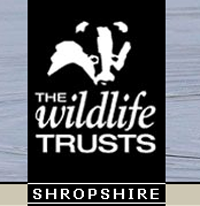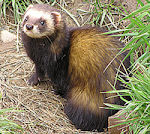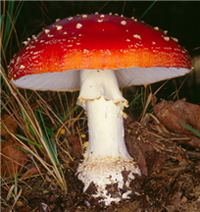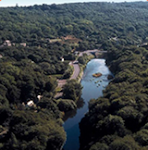Wednesday 20th August 2025, Wildgoose Nursery
Wildgoose Nursery is a small independent nursery and garden housed within the old redbrick walls of a former kitchen garden, in Millichope. Much more can be read about the nursery by going to their website - Wildgoose Nursery
The nursery is not usually open on a Wednesday so it was a privilege that were were permitted to visit.
Anticipation of the visit was high, and we had a magnificent turn out for this outing.
Unfortunately, the weather was in an uncooperative mood.
On a day when the blooms in the nursery would have been ideal for spotting visiting bees, butterflies and other invertebrates had the sun shone, the sun did not appear!
After weeks, nay, months of almost unbroken sunshine it was very disappointing that it chose this day to hide behind thick cloud and not come out to play.
Ah, well, nothing is guaranteed!
No point in moaning and groaning, we had to make the best of what the day provided.
This included the tea room that was opened up for us to have lunch with hot drinks provided…
And toilets!
Very useful.
In contrast to last week when we had to park the cars on a postage stamp we met in a large car park.
There was no trouble fitting everyone in.
The car park also contained some grassland trees and hedgerow and this provided the first diversion of the day as we explored it.
Well, most of us did, but some could not resist the draw of the nursery, and they wandered in.
Early finds around the car park were:
An Oak Ladybird, Scymnus auritus;
A Pine Ladybird, Exochomus quadripustulatus;
A larva of a 22-spot Ladybird, Psyllobora vigintiduopunctata;
A Smooth Spangle Gall, caused by the asexual generation (all female) of the wasp, Neuroterus albipes;
We left the car park and joined the advance guard in the nursery, passing our lichenologists who were peering at small growths on the brickwork of the garden wall.
We were met by the sight of a mixture of hedging, grasses and flowers. Perhaps we were a little late in the year to see the nursery in its full glory, but it was still something to behold and admire.
Clearly our normal tactic of sweeping and beating vigorously would need to be tempered so that we did not damage the blooms. Only the grasses were swept. The flowers were caressed carefully in attempts to dislodge invertebrates.
A harvestman, Leiobunum rotundum.
An attractive froghopper, a Cixius species.
Unfortunately, the Cixius was a female and could not be identified to species (by me).
A major feature of the nursery is the historic glasshouse that runs along one of the garden walls.
It was built in the 1830’s and is a remarkable construction. More information about it and its recent restoration can be found on the website using the link provided above.
Back to the gardens.
Tucked into one of the flowers a Sloe Bug, Dolycoris baccarum, was just visible.
 |
| Photograph: David Williams |
As mentioned earlier the unsympathetic weather had not encouraged bees and butterflies to put in appearance but there were a few bumble bees about and a handful of hoverflies including the “Batman” hoverfly, Myathropa florea, named as the markings on its thorax resemble (with a lot of imagination) the batman symbol.
A flea beetle, Longitarsus rubiginosus, was observed on some Bindweed.
Tucked away in the corner of the site is a scruffy area where the “weeds” rule the roost. Mainly Nettles, but other things are mixed in together with some garden waste. This was a magnet to the entomologists during the morning.
At lunch we decided that this beetle, found earlier in the morning, was a Red-rumped Ladybird, Scymnus haemorroidalis.
Some of the group visited the glasshouse in the morning. I decided to wait for the afternoon in the hope that the sun would come out and illuminate its contents.
It didn’t.
But it was still pretty bright inside.
We puzzled over some of the plants before leaving them undisturbed to continue their growth.
Back outside and continuing to wander the labyrinth of paths around the garden…
We continued to find invertebrates.
A plume moth, Emmelina monodactyla.
Another moth, this time a common micro-moth found at this time of year, Celypha lacunana.
And yet another micro-moth, Argyresthia albistria.
Inspecting plants for galls revealed this spot fungus, Septoria scabiosicola, on a leaf of Devil’s Bit Scabious.
The next photograph is of a mirid bug in the genus Lygus. Unfortunately, it is not possible to identify the species as there are several Lygus species that look the similar. They are separated by the length of the hairs and their spacing together with the distribution of punctures on the wings. Easiest done under a microscope!
A Hummingbird hawk-moth, Macroglossum stellatarum passed through.
And a Buff-tailed Bumblebee, Bombus terrestris, busied itself on one of the flowers.
Returning to the “scruffy” area we found a Dock bug, Coreus marginatus, on the vegetation.
And a ground bug, Heterogaster urticae. This is a common bug and is associated with Nettles.
Our final photographed insect for the day was a hoverfly, Eristalis arbustorum.
One last look at the garden before we left and made our way home.
My thanks to the owners for inviting us to visit and do what we enjoy doing and their hospitality. My immense gratitude to the photographers for their excellent images.
Wednesday, 30th August 2025, Lee Hill, Lee Brockhurst
This outing was cancelled when the weather forecast was for 2-3 hours of heavy rain, the remnants of hurricane Erin, starting just after we were scheduled to arrive. Not the sort of weather to be out and about looking for invertebrates.






















































































